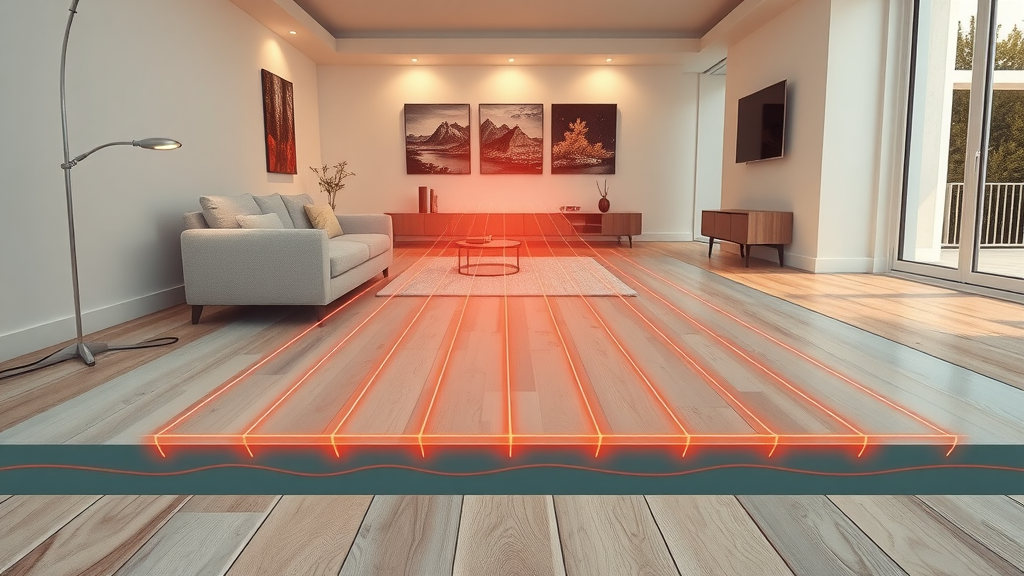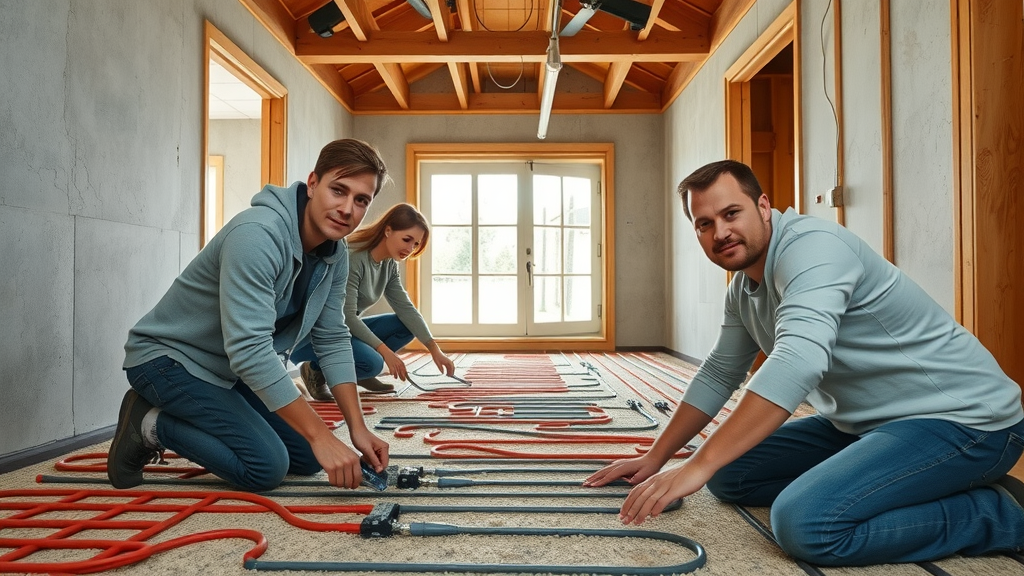Did you know that underfloor heating installations have surged by over 30% across the UK in the last five years? More and more homeowners are swapping out radiators for the best underfloor heating system, enjoying not only superior comfort but also impressively improved energy efficiency. If you’re considering upgrading your property, this guide reveals why now is the perfect time to join the growing movement—and exactly how to select the ideal heating system for your needs.
Startling Trends: Why Now Is the Time for the Best Underfloor Heating System
Across the UK, the movement towards adopting the best underfloor heating system has grown at an unprecedented pace. Thanks to advances in technology and an increasing awareness of energy efficiency, underfloor heating has transformed from a luxury home feature to a sensible, value-adding upgrade for all types of properties. Today’s modern heating systems provide homeowners with affordable running costs and flexible installation options, making them more accessible than ever before.
One compelling reason for this trend is the dramatic improvement in both electric underfloor heating and water underfloor heating technologies. Homeowners are now able to select a system that matches their specific needs, whether for a new build or a retro-fit renovation project. The increased popularity also comes from the seamless integration of underfloor heating with sustainable heating sources, such as heat pumps, which together create a more carbon-efficient home environment. As property owners seek to increase value and comfort, installing the best underfloor heating system stands out as a smart, futureproof choice.
Underfloor Heating Adoption Rates: A Market Snapshot
Recent studies show that underfloor heating adoption rates are skyrocketing in residential markets, with a particularly sharp rise in retro-fit scenarios where traditional radiators are replaced. In fact, more than one in five new UK homes now includes some form of underfloor heating system from the outset. This growth is driven not only by consumer demand for comfort and energy savings but also government incentives and energy-efficiency regulations making these upgrades more attractive. As the market continues to evolve, homeowners who act now are poised to benefit from rising property values and lower heating bills in the years to come.

"More UK homeowners are turning to underfloor heating systems for their efficiency, comfort, and property value boost — especially in retro-fit scenarios."
What You’ll Learn About the Best Underfloor Heating System
Key distinctions between electric underfloor heating & water underfloor heating
Factors for selecting the best underfloor heating system for your home
Installation process and project considerations for underfloor heating installation
Insights on efficiency, cost, and property value
Why residential property owners are choosing modern heating systems
Understanding the Best Underfloor Heating System: Electric, Water, and Hybrid Options
Choosing the best underfloor heating system for your home means understanding your main options. There are three primary systems: electric underfloor heating, water (wet) underfloor heating, and hybrid systems. Each system has unique features, benefits, and considerations. Your property type (new build or retro-fit), floor coverings, and energy efficiency priorities will influence your selection. In this section, we’ll break down the differences and help you navigate the choices confidently.
With energy prices fluctuating and sustainability under the spotlight, opting for the right underfloor heating system directly impacts your comfort, bills, and property value. The best underfloor heating system also increases design freedom, banishing bulky radiators and enabling stylish, uncluttered interiors. Whether you want a fast installation, maximum savings, or complete home control, there’s a solution for every need.
For a more detailed look at how to match underfloor heating types to your specific property and lifestyle, you might find it helpful to explore this comprehensive guide on choosing the best underfloor heating system for your home in Chesterfield, which covers practical considerations and local insights.
Exploring Electric Underfloor Heating Systems
Electric underfloor heating uses thin, flexible heating mats or wires installed beneath your flooring. These systems are an excellent choice for retro-fit projects or where floor buildup needs to be minimal. Popular in smaller rooms or renovations, electric systems heat up quickly and are relatively simple to install. Because electric underfloor heating doesn’t require a boiler or pipes, it’s perfect for spaces like bathrooms, kitchens, or conservatories where precise warmth and easy installation are essential.
When it comes to running costs, electric underfloor heating is often more expensive per kilowatt than water systems, but because it’s typically used in smaller areas, overall expenses remain manageable. Advanced controls allow for smart scheduling, lowering wasted energy and enhancing comfort. Homeowners seeking a disruption-free upgrade frequently select electric heating mats for their convenience and adaptability to various floor coverings.

What is Water Underfloor Heating? Warm Water Systems Explained
Water underfloor heating, also known as “wet” or “hydronic” systems, circulates warm water through a network of pipes laid beneath the floor. Connected to your existing boiler, heat pump, or other renewable source, this system delivers widespread, even heat throughout entire rooms or whole homes. It’s the preferred option for larger spaces, open-plan areas, and new builds due to its exceptional efficiency and integration with mains heating systems.
While the initial underfloor heating installation cost for water systems is generally higher than electric options, the running costs can be significantly lower—especially if paired with modern heat pumps or renewable energy. Warm water underfloor heating is often considered the gold standard for energy-conscious homeowners, boasting long lifespans and compatibility with a wide range of flooring materials, including tile, engineered wood, and certain types of carpet.
Hybrid & Advanced Underfloor Heating Systems
Hybrid underfloor heating systems combine both electric and water technologies, offering maximum flexibility for complex homes or phased renovations. For example, you may opt for electric underfloor heating in bathrooms, where fast response times matter, and water underfloor heating in open-plan living spaces for cost-effective, long-term comfort. Some advanced systems also integrate seamlessly with heat pumps and smart home controls, boosting efficiency and responsiveness with features like zoning, app management, and smart thermostats.
Hybrid systems deliver the best of both worlds but require careful design and expert advice to ensure compatibility and performance. When a property includes multiple heating zones, or when blending heating sources is desirable, hybrid underfloor heating solutions are uniquely effective. Consulting with professionals like Peak Underfloor Heating Ltd ensures your system design is tailored for maximum value and comfort.
Comparing Underfloor Heating Systems: Cost, Efficiency, and Comfort
Let’s compare electric underfloor heating, water underfloor heating, and hybrid options side by side. Each has unique installation requirements, operating costs, and suitability depending on your home and preferences. By weighing factors like cost, energy usage, and compatibility with your preferred floor coverings, you can confidently pick the best underfloor heating system for your project.
While upfront installation costs may differ, considering the long-term running costs and energy efficiency is crucial. Water systems tend to pay off for larger spaces or whole-home heating, while electric options provide affordability and speed for single-room upgrades. Hybrid solutions are emerging as a savvy choice for mixed requirements in modern homes.
Comparative Analysis: Electric vs Water Underfloor Heating vs Hybrid |
|||
Feature |
Electric Underfloor Heating |
Water Underfloor Heating |
Hybrid System |
|---|---|---|---|
Running Cost |
Higher per kWh, best for small areas |
Lower, especially with heat pumps and renewables |
Varies, combines pros/cons of both |
Installation Cost |
Lower initial cost, quick install |
Higher upfront, professional install needed |
Moderate—depends on split |
Efficiency |
Quick warm-up, zone specific |
Very efficient across large spaces |
Highly efficient with smart controls |
Lifespan |
20–25 years |
30+ years with maintenance |
Long; maintenance varies by zone |
Floor Compatibility |
Tiles, laminate, engineered wood, some carpet |
Tile, stone, engineered wood, some carpet |
Works with most flooring types |
How Underfloor Heating Systems Work in Modern Homes
The best underfloor heating system blends science and design. At its core, underfloor heating uses radiant heat, warming surfaces evenly across the entire room. This ensures that the space is heated from the ground up, which feels more comfortable than the convection currents produced by radiators. As a bonus, modern underfloor heating systems maintain low running costs when integrated with smart controls and efficient energy sources like heat pumps.
Most of today’s underfloor heating systems are concealed beneath stylish floor coverings, freeing up wall space and allowing uninterrupted interior design flow. Whether you choose electric or water options, the technology provides consistent warmth without cold spots. Plus, by controlling zones and integrating with renewable technology, you gain tailored heating control and sustainability for your home.
The Science Behind Underfloor Heating System Design
Underfloor heating works by spreading heat across a wide area just beneath your floors, using either electrical matting or a labyrinth of warm water pipes. This creates a radiant effect, where all surfaces in a room are gently warmed. Thanks to low flow temperatures, water-based systems in particular can be paired with renewable technologies (like heat pumps) to deliver remarkable efficiency.
The best underfloor heating system design hinges on effective insulation, the right floor covering, and precise controls. When expertly installed, heat rises slowly and evenly, keeping the room consistently warm without hotspots or draughts. Not only does this feel more luxurious, but it also results in lower energy usage compared to traditional radiator heating, supporting lower bills and environmental impact.

Compatibility with Heat Pumps and Other Heating Systems
Pairing your underfloor heating system with a heat pump is a powerful way to amplify savings and performance. Heat pumps operate efficiently at the lower water temperatures ideal for wet underfloor heating, making this duo a popular choice for energy-efficient homes. Hybrid heating systems can also be designed to integrate with existing boilers, solar thermal panels, or other renewables, delivering flexible heating that grows with your needs.
An expert installer will assess your home’s insulation, heating zones, and hot water requirements to ensure the system is optimized. This approach not only guarantees comfortable heating but also futureproofs your home as building regulations tighten and demand sustainable solutions.
Key Considerations: Choosing the Best Underfloor Heating System for Your Property
Retrofitting in existing properties
Heating installation timelines and disruption
Floor coverings and compatibility
Heating zones and system controls
When you’re choosing the best underfloor heating system, assess whether your project is a new build or a renovation. Retrofitting systems into existing homes may require different floor build-up or insulation methods. Next, review the likely disruption—while electric mats and foil systems are minimally invasive, wet systems may require professional floor lifting. You’ll also want to match your preferred floor coverings (like tile, engineered wood, or luxury carpet) to system type, ensuring optimal performance.
Another key advantage of today’s underfloor heating systems is the ability to create “zones.” This means different rooms or spaces can be controlled independently, enabling energy savings and personalised comfort all year round. Advanced system controls and timers enhance convenience, delivering warmth only where and when it’s needed, and reducing your overall energy consumption.
The Role of Floor Coverings in Underfloor Heating Performance
Floor coverings play a critical role in the effectiveness of your underfloor heating system. The wrong choice can restrict heat transfer and impact efficiency. The best underfloor heating system works harmoniously with materials that conduct heat well, like tiles or engineered wood. As each flooring material responds to underfloor heating differently, choosing compatible options is a must for maximum benefit.
Whether you opt for new build installations or retro-fit upgrades, always consult your heating specialist about floor covering compatibility. They’ll provide expert advice on achieving your warmth, style, and durability goals—ensuring your investment delivers year after year.
Top Recommended Floor Coverings for Underfloor Heating Systems
Popular and effective floor coverings for underfloor heating include porcelain and ceramic tiles, which offer unbeatable heat transfer and suit both electric and water-based systems. Engineered wood is another excellent option, marrying visual warmth with practical heat conduction. Luxury vinyl and some modern laminates are also compatible, as long as they’re specifically rated for use with underfloor heating.
While carpet can be used, it must be of low tog (thermal resistance) to allow efficient heat passage. Always check with your supplier or installer that your chosen flooring for underfloor heating is compatible, and avoid excessive thickness which can impede performance. With the right covering, your new best underfloor heating system provides comfort, efficiency, and style in one package.

Floor Covering Pitfalls: What to Avoid
Steer clear of thick, dense carpets or rugs that block heat flow from your underfloor heating system. Similarly, natural hardwoods may expand and contract excessively with temperature changes, causing warping or gaps. Stone floors offer excellent heat transfer but need proper insulation underneath. It’s crucial to avoid any floor coverings that aren’t rated for underfloor use, as they can lead to poor heating performance, safety hazards, or voided warranties.
Consult with flooring and heating experts before committing. Doing so helps sidestep common mistakes, preserve your investment, and guarantee that your choice of floor complements—not hinders—your search for the best underfloor heating system.
Installation Insights: What Homeowners Need To Know About Underfloor Heating Installation
Preparation is the key to a stress-free installation of underfloor heating systems. Understanding the project timeline, disruption levels, and what’s required from each party makes for a smooth upgrade. Whether you’re retrofitting a period property or specifying underfloor heating for a new build, your installer’s expertise will make all the difference in speed, finish, and lifetime performance.
Many homeowners find that professional project management from a trusted provider, such as Peak Underfloor Heating Ltd, reduces stress and maximises results. From initial survey to completion, expert support delivers consistent warmth and peace of mind—making your investment in the best underfloor heating system truly worthwhile.
Project Timeline and Stages for Retro-fit Underfloor Heating
Retro-fit installations begin with an in-depth survey and consultation to determine the most suitable underfloor heating system for your property. Next comes surface preparation—removing existing flooring and cleaning the sub-floor. For electric systems, heating mats or wires are laid and connected to your electrical supply, while water underfloor heating requires fitting pipework and connecting to a manifold, boiler, or heat pump.
After installing the heating system, new insulation and floor coverings are fitted. Electrical and control system integration ensures your new heating solution is safe and responsive. The final stage is a thorough test to confirm performance. For most homes, a full retro-fit project takes a few days to two weeks, depending on scope and complexity. Your installer will outline a clear timetable and minimise disruption wherever possible.

Choosing an Installer: Why Peak Underfloor Heating Ltd Stands Out
Selecting an experienced installer for your underfloor heating system is as important as the system itself. Peak Underfloor Heating Ltd rises above the rest with their commitment to quality, customer service, and tailored designs. With decades of experience in both new builds and complex retro-fit projects, their expert advice ensures your upgrade is smooth, cost-effective, and delivers long-term rewards.
Their workmanship comes with robust guarantees, and the team’s detailed approach ensures every installation meets the highest industry standards. From full project management to aftercare, Peak Underfloor Heating Ltd is the trusted partner for UK homeowners seeking to elevate their comfort, lower their energy bills, and add value to their property with the best underfloor heating system.
"Expert installation increases both the efficiency and longevity of your chosen underfloor heating system."
Best Underfloor Heating System for New Builds vs Retrofits
The choice of underfloor heating system often depends on whether you’re building a new home or upgrading an existing one. New builds typically offer more flexibility in design and installation, enabling expansive, energy-efficient wet systems. Conversely, retro-fit projects require solutions that minimise disruption and work with your existing floors and infrastructure.
For both scenarios, consulting an expert early in the process helps you choose the best underfloor heating system for your specific requirements, ensuring lasting value and comfort.
Underfloor Heating Systems for New Build Projects
New builds provide the perfect opportunity to incorporate water underfloor heating throughout the home, making the most of the larger floor area and seamless installation possibilities. With open floor plans and fresh insulation, these projects achieve exceptional energy efficiency and even heat distribution. Wet underfloor heating can also be futureproofed to work alongside heat pumps or solar energy, aligning your home with Net Zero goals.
Best of all, tailoring your floors, controls, and zones at the design stage ensures a bespoke, high-performance heating solution that adds immediate and long-term value. Leading underfloor heating installers will collaborate closely with architects and builders to create a system that perfectly suits your lifestyle, budget, and sustainability ambitions.
Adapting Underfloor Heating To Older Homes: Retrofit Solutions
Bringing underfloor heating to existing homes requires specialist retro-fit solutions. Electric heating mats and slimline water systems have been engineered to fit around older properties’ constraints, working over suspended or solid floors without major upheavals. Advanced designs even allow for selective heating in high-use rooms or areas with challenging layouts.
Retro-fit projects can also benefit from smart controls, programmable heating zones, and responsive thermostats, giving you customisable warmth and minimum disruption. With expert planning and installation, you’ll enjoy luxurious heating comfort and lower energy bills, even in Victorian terraces or period properties where traditional radiators once dominated.
Watch: Animated explainer – How underfloor heating systems transform retrofit properties
Underfloor Heating and Energy Efficiency: Lowering Your Bills
The best underfloor heating system is designed with energy savings in mind. By heating rooms more evenly and at lower temperatures than standards radiators, underfloor heating systems help you trim your heating bills while maintaining year-round comfort. This is especially true when systems are paired with renewable energy sources or efficient controls.
Smart controls and zoning, now standard on most modern systems, give homeowners greater command over when and where heat is delivered. This targeted approach not only reduces energy use but also extends the lifespan of heating components, providing further value for your investment.
Understanding Running Costs and Energy Savings
Electric underfloor heating is cost-effective for small spaces or sporadic use but can be expensive for whole-home heating due to higher electricity prices. Water underfloor heating, though more expensive to install, offers impressive savings on running costs, especially when combined with a heat pump. According to industry research, warm water underfloor heating can reduce energy consumption by up to 25% compared to traditional radiator systems.
Investing in precise thermostats, timed controls, and smart apps will further slash your home’s energy use by ensuring heat isn’t wasted. Always factor in the insulation and airtightness of your home—better insulation means you get maximum efficiency and comfort from your best underfloor heating system.
How Heat Pumps Integrate with Underfloor Heating Systems
Heat pumps are a game-changer for eco-conscious homeowners. When paired with wet underfloor heating, heat pumps safely operate at lower temperatures, squeezing more efficiency from your heating and boosting energy savings. This collaboration is ideal for both new builds and retro-fit projects where sustainability and cost control are key.
The latest smart underfloor heating systems communicate with heat pumps, adjusting output based on external weather and internal occupancy. This ‘smart synergy’ ensures minimal running costs and more stable bills even as energy prices fluctuate. By choosing an integrated approach, you futureproof your home and benchmark it against evolving energy standards.
People Also Ask: Best Underfloor Heating System Questions Answered
What is the best type of underfloor heating system?
The best underfloor heating system depends on your home’s needs. For whole-house efficiency or new builds, water underfloor heating (wet systems) is often considered superior due to lower running costs and compatibility with renewables. For small or individual rooms, electric systems offer fast installation and versatility. Hybrid solutions are ideal for mixing these benefits in complex projects or phased upgrades.
What is the downside of underfloor heating?
While underfloor heating brings comfort and value, there are potential downsides. Wet systems can have high upfront installation costs, especially during retro-fit projects, and poor insulation may hamper efficiency. Some floor coverings (like thick carpet or solid hardwood) limit performance. Installation can be disruptive, but using a professional installer helps mitigate this and ensures optimal results.
What is the cheapest underfloor heating to run?
Water underfloor heating is typically the cheapest long-term option, especially when coupled with a heat pump or renewable source. Electric underfloor heating suits small areas but carries higher energy costs for extensive use. Smart controls, zoning, and good insulation are the secrets to keeping any system’s running costs in check.
Is dry underfloor heating better than wet?
Dry (electric) underfloor heating is easier and quicker to install—ideal for specific rooms or retro-fits. Wet (water-based) underfloor heating delivers better efficiency across large spaces and is preferred for new builds or full renovations. The choice depends on the size, layout, and intended use of each area in your home.
Customer Insights: Underfloor Heating System Success Stories

Modernising a Victorian terrace with electric underfloor heating
Lowering energy bills in a new-build home with water underfloor heating
Retro-fit project: Combining underfloor heating systems with smart controls
UK homeowners are reaping the rewards of upgrading to underfloor heating. One family in a Victorian terrace saw both aesthetic and efficiency improvements after installing electric heating mats throughout their living and dining rooms, finally saying goodbye to draughty old radiators. A new build customer reported slashed energy bills and luxurious comfort all year round after opting for a full wet underfloor heating system, coupled with a modern heat pump. And in a recent retro-fit, smart controls allowed a homeowner to mix electric and water systems, perfecting each room's comfort and maximising efficiency.
Expert FAQ About the Best Underfloor Heating System
Can I install underfloor heating under any floor covering?
Not all floor coverings are suitable. Porcelain tiles, engineered wood, and some laminates work well; thick carpets or solid hardwoods may impede heat flow and are best avoided. Always check compatibility with your installer before you buy.How disruptive is the installation?
Installation disruption varies. Electric systems are often minimally invasive, while wet systems may require lifting floors and more extensive prep. Professional installers manage the process to keep disruption low and finish quickly.What guarantees come with the best underfloor heating systems?
Peak Underfloor Heating Ltd and reputable suppliers offer strong guarantees—often up to 30 years for water pipework and 10–15 years for electric mats. Be sure to verify warranty details before commencing work.Will underfloor heating work with my existing heating system?
Most modern underfloor heating systems integrate well with current heating solutions, including boilers and heat pumps. Expert installers ensure controls and settings are aligned for safety and efficiency.
Key Takeaways: Why Invest in the Best Underfloor Heating System
Improved comfort and efficiency
Adds value to your property
Integrates with today’s sustainable heating systems
Peak Underfloor Heating Ltd: The trusted partner for your project
Conclusion: Making Your Choice in the Best Underfloor Heating System
Choosing the best underfloor heating system brings your home into the future—offering lasting comfort, major energy savings, and greater property value. Consult Peak Underfloor Heating Ltd to ensure your project is expertly designed and installed for years of satisfaction.
If you’re eager to deepen your understanding of underfloor heating and want to explore how different systems perform in real-world UK homes, consider reading further about the strategic factors that influence system selection and installation. By learning from local case studies and expert recommendations, you’ll be better equipped to make confident decisions that align with your property’s unique needs. Take the next step and discover advanced tips for choosing the most effective underfloor heating solution by visiting our in-depth resource on underfloor heating systems in Chesterfield—your journey to a warmer, more efficient home starts with the right knowledge.
Sources
Energy Saving Trust – https://www.energysavingtrust.org.uk/advice/underfloor-heating/
Which? – https://www.which.co.uk/reviews/underfloor-heating/
Peak Underfloor Heating Ltd – https://www.peakunderfloorheating.com/
When selecting the best underfloor heating system for your home, it’s essential to consider various factors such as system type, installation requirements, and compatibility with your flooring. For a comprehensive understanding of underfloor heating options, including the distinctions between electric and water-based systems, as well as their respective benefits and considerations, you might find the article “Considering underfloor heating? How to choose the right system for your project” particularly insightful. (homebuilding.co.uk) This resource delves into the advantages of underfloor heating, such as energy efficiency and design flexibility, and provides guidance on selecting the appropriate system for your specific needs.
Additionally, if you’re interested in exploring top-rated underfloor heating kits that offer ease of installation and efficient performance, the article “Best Underfloor Heating Kits: Achieving Cozy Comfort in Your Space” reviews several high-quality options. (rustictools.com) This guide evaluates various kits, highlighting their features and suitability for different flooring types, helping you make an informed decision tailored to your home’s requirements.
By consulting these resources, you can gain valuable insights into the selection and installation of underfloor heating systems, ensuring a comfortable and energy-efficient environment in your home.
 Add Row
Add Row  Add
Add 









Write A Comment